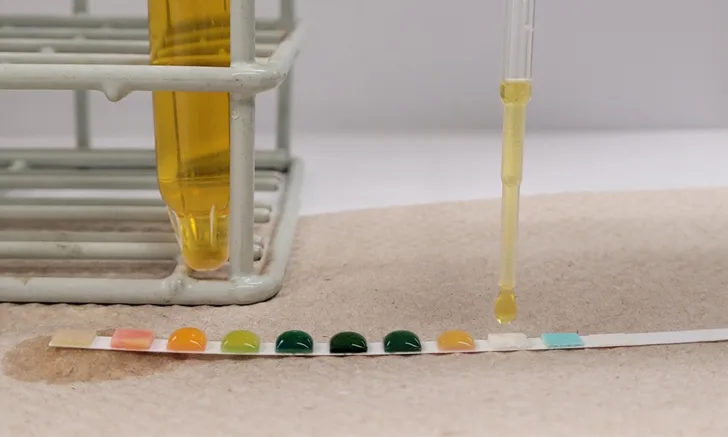
Complete urinalysis (ie, urine specific gravity, dipstick, sediment) is part of the minimum database but is not performed with every CBC1; however, conditions that may not cause clinical signs or abnormalities on routine hematologic and biochemical testing may be detected via urinalysis.
Following are the top conditions that can be missed if urinalysis is not performed, according to the author.
1. Proteinuria
Proteinuria screening is recommended during annual examination of healthy dogs and cats because proteinuria may be the only clinicopathologic abnormality in patients with uncomplicated glomerular diseases without hypoproteinemia or azotemia.2,3
Discussion of proteinuria focuses on location, persistence, and magnitude.2 Protein in urine can be associated with prerenal, postrenal, or renal causes (tubular or glomerular).
When proteinuria is first detected on urinalysis (likely via dipstick), urine protein:creatinine ratio (UPC) should be measured on 3 or more occasions, 2 or more weeks apart, to demonstrate persistent proteinuria.2 In dogs with known protein-losing nephropathy, a single measurement of UPC is comparable to an averaged or pooled sample (ie, combination of 1 urine sample each from 3 days), and free-catch samples can be used.4 UPC ≥2 is more indicative of glomerular proteinuria than tubular proteinuria2; however, lower UPC in patients with early glomerular diseases may complicate distinction between tubular and glomerular diseases. In these patients, a urine sample can be submitted to an outside veterinary pathology laboratory for the sodium dodecyl sulfate polyacrylamide gel electrophoresis (ie, SDS-PAGE) banding pattern to supply additional information.5
Patient history, physical examination, CBC, serum chemistry profile, complete urinalysis, and urine culture (when appropriate) are recommended in addition to ruling out infectious diseases (eg, tick-borne disease, leptospirosis) associated with renal proteinuria in dogs with persistent renal proteinuria without hypoalbuminemia or azotemia.2
2. Glucosuria: Fanconi Syndrome
Glucosuria in euglycemic or hypoglycemic patients should prompt investigation for proximal renal tubule defects seen with Fanconi syndrome. In addition to glucosuria, amino acids, bicarbonate, other ions, and low molecular weight proteins may be found in the urine.6 Inherited Fanconi syndrome is most commonly described in basenjis7; however, acquired Fanconi syndrome has been reported in patients with ethylene glycol toxicosis, drug reactions, metabolic and infectious diseases, or a history of chicken jerky treat ingestion.8
In dogs with chicken jerky treat-associated Fanconi syndrome, clinical signs (eg, lethargy, polyuria, polydipsia, anorexia) and common serum chemistry profile abnormalities (eg, hypokalemia, hypophosphatemia) are often nonspecific.6,8 One study found that only 27% of dogs were azotemic, and moderate-to-marked glucosuria (ie, 3+ to 4+ on dipstick) and mild proteinuria (ie, ≥1+) in most of the affected dogs would have been missed without urinalysis.8
3. Bacteriuria: Subclinical Bacteriuria
Unstained, wet-mount urine sediment evaluation is a reliable diagnostic test for bacteriuria. A positive wet-mount evaluation has moderate to high sensitivity (64%-89%) and high specificity (91%-97%) for predicting positive culture results.9,10 Samples with rod-shaped bacteria and urine specific gravity ≤1.012 tend to have good agreement between microscopic evaluation and bacterial culture.10 Samples without hematuria, pyuria, or bacteria are unlikely to have positive growth.10
UTI is a clinical diagnosis, whereas subclinical bacteriuria is presence of positive culture results in patients without clinical signs of UTI. In some studies, the term subclinical bacteriuria is also used when urine sediment shows evidence of inflammation (eg, pyuria, hematuria) in the absence of clinical signs.11,12 Subclinical bacteriuria can occur in healthy dogs (2.1%-12%) and cats (6.1%-13%).12,13 Higher prevalence has been reported in dogs with comorbidities (eg, endocrine diseases, immunosuppressant treatment, other urinary tract diseases); however, one study showed only 13% of diabetic dogs have subclinical bacteriuria.14,15 Female cats are predisposed to subclinical bacteriuria, but prevalence does not differ between healthy cats and those with comorbidities.11
Antimicrobial treatment is unnecessary in humans with asymptomatic bacteriuria.16 Studies in small animals do not support use of antimicrobials for subclinical bacteriuria, as there is no association with development of cystitis or other infectious complications.13
Conclusion
Urinalysis is an inexpensive, easy-to-perform, and highly useful diagnostic tool that can reveal abnormalities undetected on routine CBC and serum chemistry profile and can be performed in-house without delays due to shipping. Urinalysis should be considered as part of the minimum database in older and/or sick patients to allow early detection of disease or trends that warrant further investigation.
Listen to the Podcast
Don't miss Dr. Chu's insights on how to perform accurate and efficient in-house urinalysis.